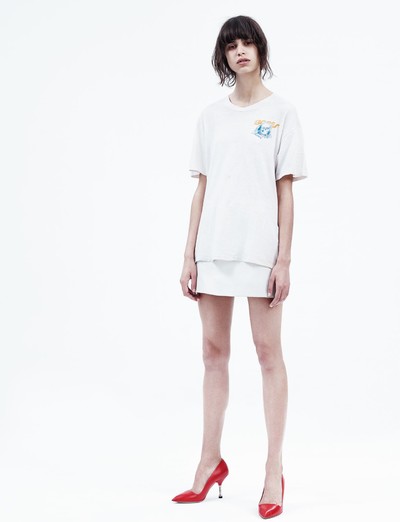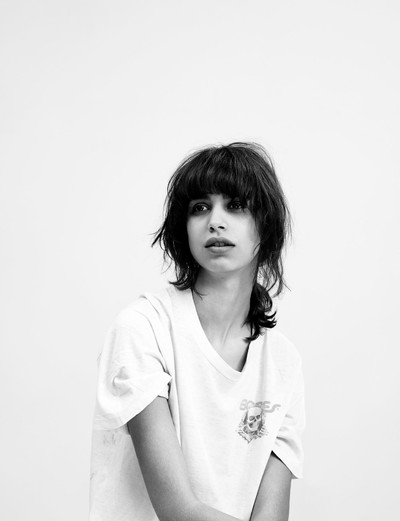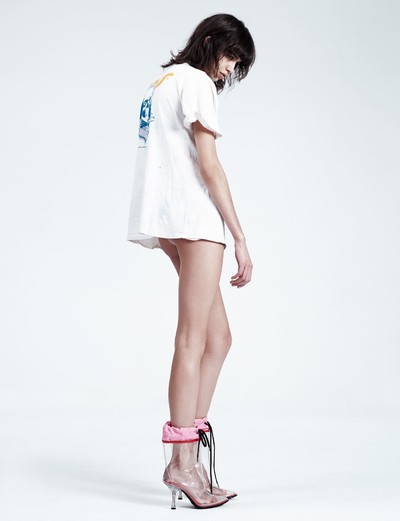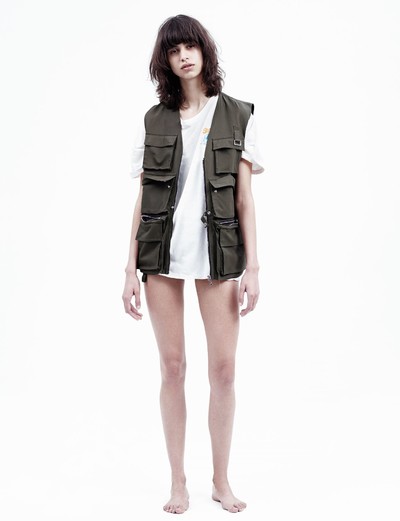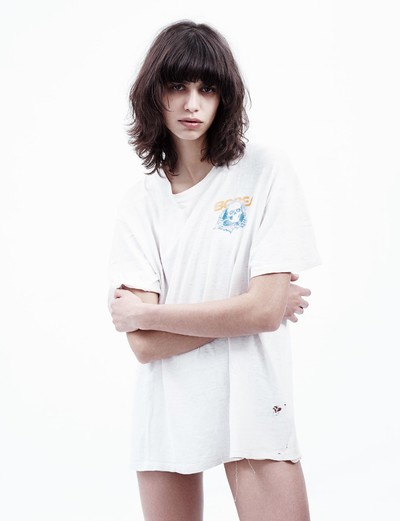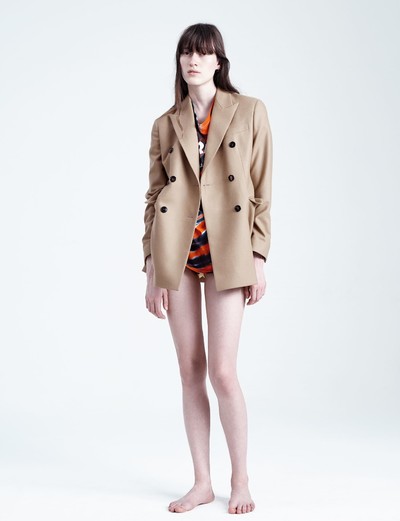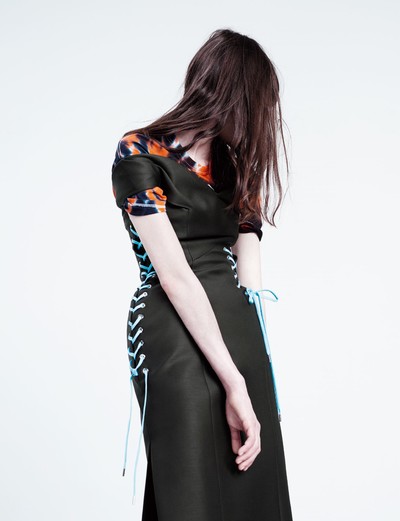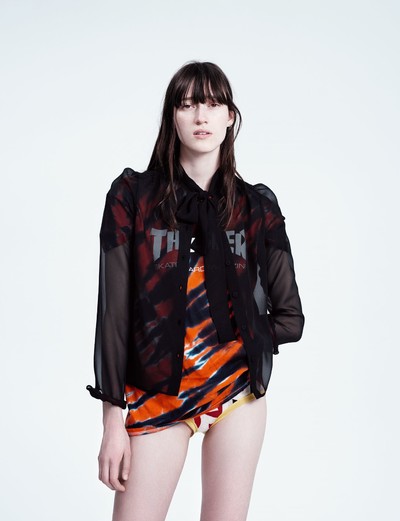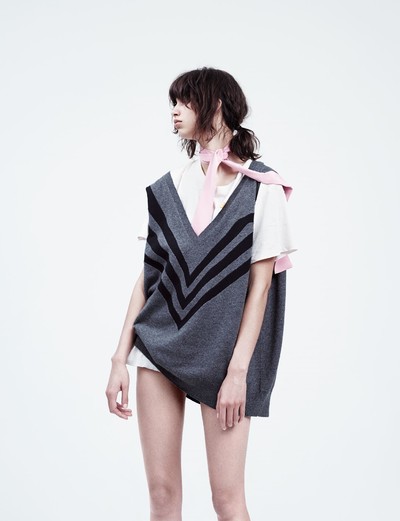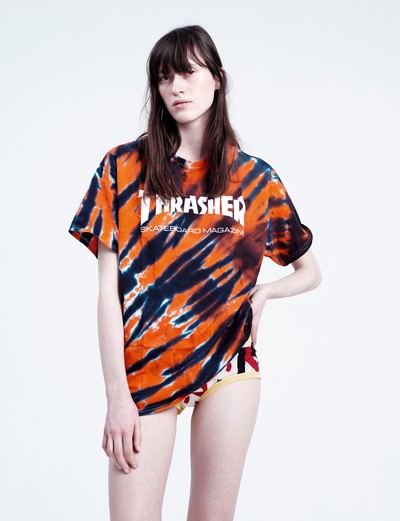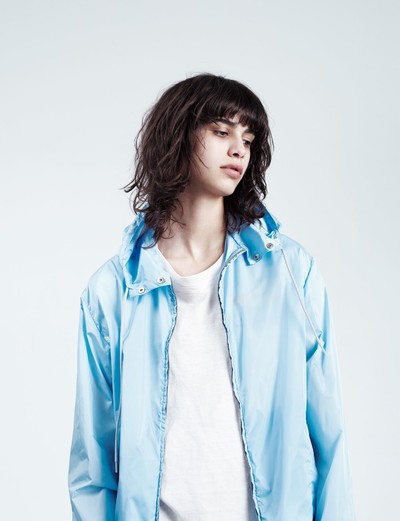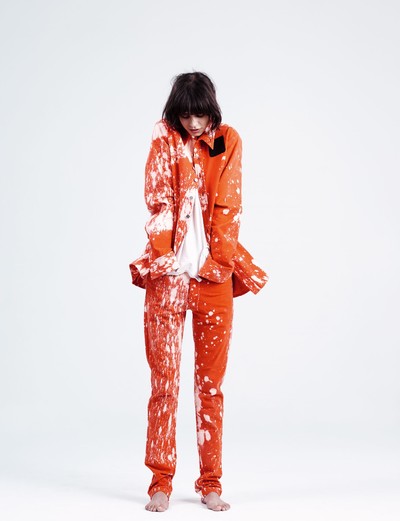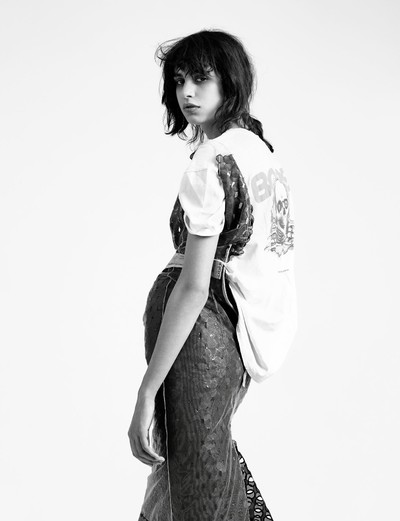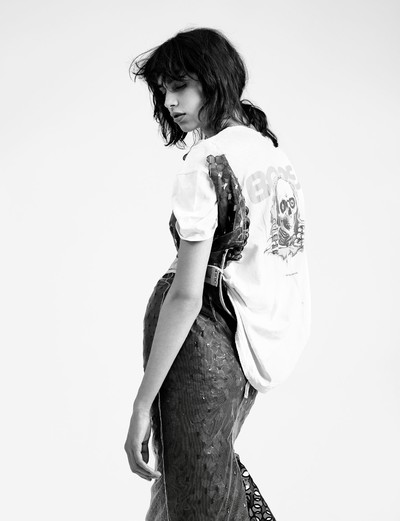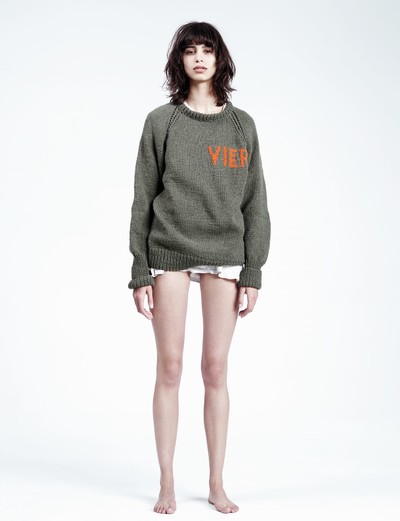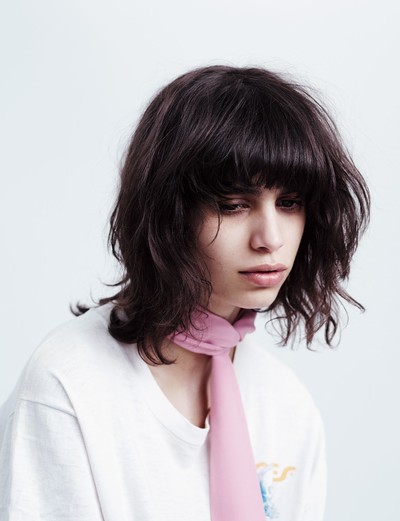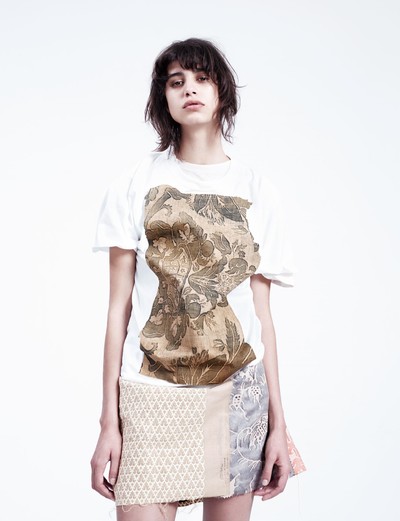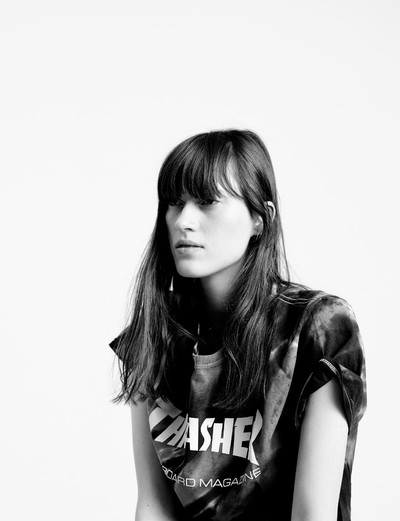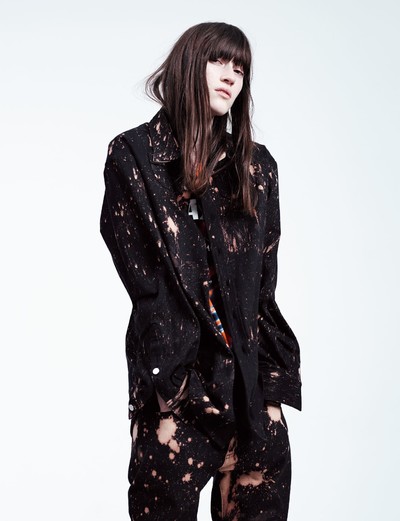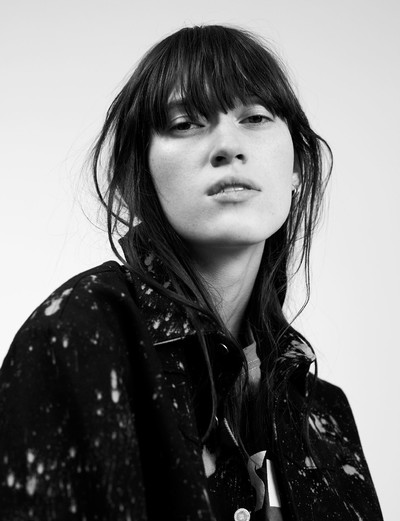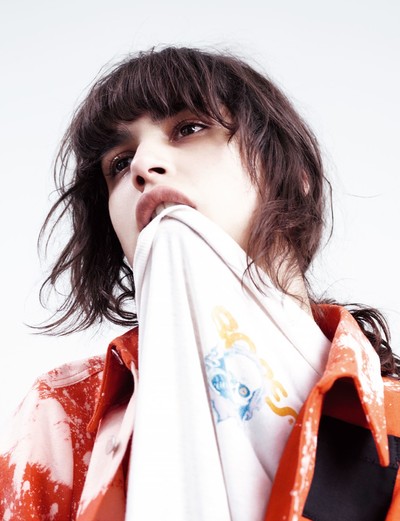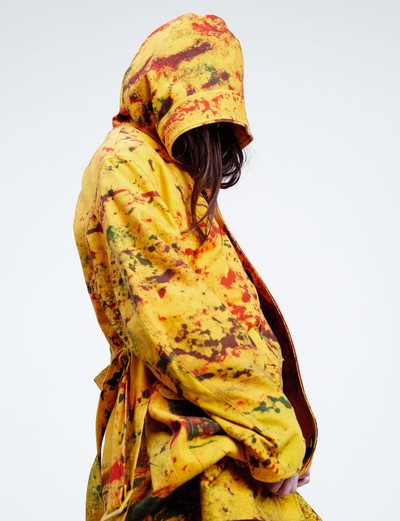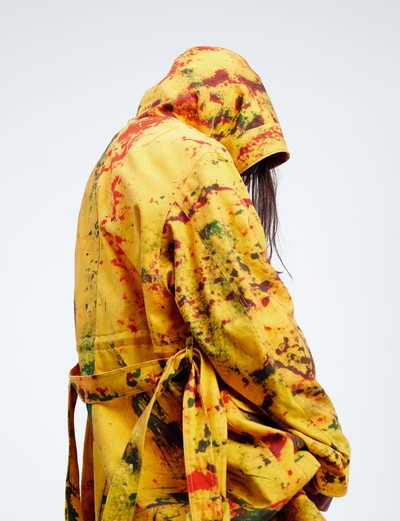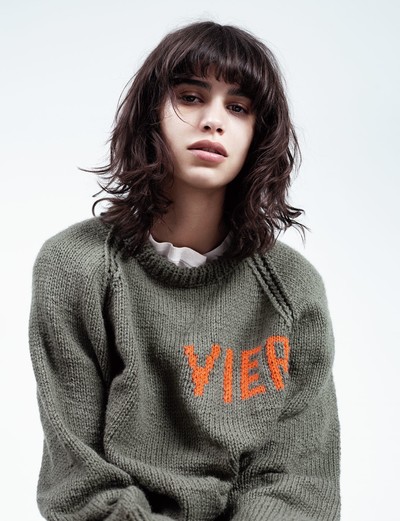From Antwerp to Avenue Montaigne, how Willy Vanderperre and Olivier Rizzo’s love of skate and club culture has shaped high fashion.
By Rana Toofanian
Photographs by Willy Vanderperre
Styling by Olivier Rizzo
From Antwerp to Avenue Montaigne, how Willy Vanderperre and Olivier Rizzo’s love of skate and club culture has shaped high fashion.
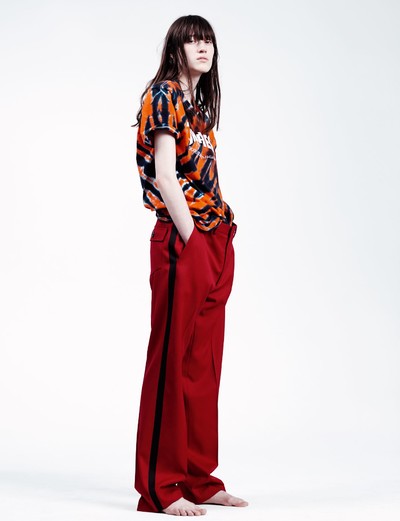
Willy Vanderperre and Olivier Rizzo formed an instant connection when they met while studying photography and fashion, respectively, at Antwerp’s storied Royal Academy of Fine Arts. It was a bond formed by a shared love of skate culture, and an approach to fashion formed from vague glimpses of what lay beyond small-town Belgium in the late 1980s. They considered themselves outsiders, witnesses of a seismic cultural shift, as the extrovert glamour of the 1980s was swept away by the moody rebellion of early-1990s grunge.
The irony is that as a photographer-stylist outsider duo who still live together in Antwerp, they’re very much at the forefront of the fashion industry today. Through shooting, styling and casting campaigns and catwalk shows for the likes of Prada and Miu Miu – and with their fellow Belgians Raf Simons and make-up artist Peter Philips on the overall creative direction of that most venerated of fashion houses, Christian Dior – they’ve cultivated an artistic sensibility that’s uniquely theirs. One that fetes purity of spirit and celebrates the romanticism of youth, occupying a sense of calm found in the territories that lie between the gloss of glamour and the grain of grunge.
It’s an approach to fashion imagery that is quite often led by their casting and a vision of beauty that cannot be easily labelled as masculine, feminine, or indeed androgynous. It is instead a vision of gender that’s perhaps best described by the title of Raf Simons’ seminal 2003 book, The Fourth Sex: Adolescent Extremes, for which they created the remarkable cover image.
For System, the pair agreed to discuss their creative dynamic, their early exposure to fashion and their approach to image-making. In a series of deeply personal images crystallising their vision of femininity in 2014, the duo have also photographed their favourite skate T-shirts – Olivier’s vintage Bones Brigade shirt dug out of his closet, Willy’s current season Thrasher merchandise – alongside a selection of their favourite pieces of the season.
Rana Toofanian: How do you cultivate your ideas of beauty, femininity and fashion within your collaborations? Do they come from fashion or from art?
Willy Vanderperre: I think it’s an infusion of both or neither. But also so much more than just art or fashion – it’s daily information, impulses, emotions, past experiences and visions of the future. Of course we go to view art, and when you are in the field of fashion, you look at fashion shows and at models. So that is always a representation, but there’s a difference between the reality of the woman or girl on the street, and the fashion girl that is presented on the runway. Wherever it is in the world, you walk the street and you get the impulses of the youngsters that are around. That’s always the most interesting source of inspiration, no?
Olivier Rizzo: Or you get bored with everything and you do something completely different, and you open up your world of references; I guess that everybody has their own world of references, anything you can be sensitive to, that triggers something within you. In that sense it can be art or film. Actually quite often, you treat fashion imagery as a pure fiction of fantasy because fashion is fantasy. Making fashion imagery is creating a fantasy. Sometimes you create a dream, sometimes not.
In that sense, it’s theatre. Sometimes we go to create a character in which you can see a reference, and other times we just go completely free. We always allow the moment to take over. Spontaneity. In the process, for certain reasons – whether it’s the location, or the character, or the fashion – things might change, go another way, and all of a sudden it might look much more interesting.
Willy: You have to allow it, to free itself from any constrictions.
‘The process is the most natural, logical thing to us. It’s almost telepathy – we go from one thoughtto another in the blink of an eye.’
How do you think your visual language and aspirations were influenced by the era in which you studied in Antwerp, by the people you were surrounded by, and by the scene in the city at that time? To what extent does that still influence what you’re doing today?
Willy: I think there is a certain key point where during the full development of your taste, your senses, and your references, you start to connect with people – your generation of peers. Mostly, those are the people you carry with you for the rest of your life. You grow together, and you share thoughts, reflections. In a way you develop a language between each other. With Olivier, it’s almost telepathy, because we are so infused with each other that we go from one thought to another in the blink of an eye. This process is the most natural, logical thing to us, whereas, for an outsider, it might not be. When we met, in the late 1980s in Antwerp, we already shared the same mind-set and sensibility. I think it was the same with the people that we met when we were there. It was Raf [Simons], it was Peter [Philips], it was [the artist] Peter de Potter. They are all people we grew with.
Olivier: Absolutely. The thing that we realised later is how much the moment that we all came to Antwerp – from wherever we came – influenced us.
As a late teenager, you hit the Academy, a 17th-century building, being part of, in general, a dark thinking, poetic generation, full of fear of the next day. It was this incredible, dark, dramatic, kind of temple, with hallways that had no end, and literally falling-down huge statues from the ateliers of the painters. It felt like walking straight into a Flemish painting. We sat there in that hallway for four years, day in, day out, from 8:30 in the morning in this beautiful, black historic building. It’s not supposed to be black, but it’s so run down! [Laughs]
Willy: Poorly lit.
Olivier: Indeed, poorly lit, nearly no daylight. There’s a mood, a certain kind of poetry that exists there. And between all of that, there was a change of culture – the break from the 1980s into the 1990s.
Ah, grunge.
Olivier: We arrived being major Gaultier fans, and at the end of the year it was all about Martin Margiela. One moment, you’re listening to Madonna, and the next you’re listening to Nirvana.
Willy: When we entered the Academy, in our late teens, we were completely fashioned up. I think everybody was dressed up. Then all of a sudden grunge and Margiela came. It was like life changed overnight, music being the catalyst. When the Nirvana album came out, it changed everything. Because at the same time fashion was collapsing, destroying what was from the 1980s. Back then I was a club kid. I remember partying at the closing night of the club 554 in Kuurne, in West Flanders: there was techno, and then the DJ mixed in Smells Like Teen Spirit and people danced to it. Whereas before, if you had played a rock’n’roll song in that club, you would have seen the dancefloor empty in a second. That really was quite impressive. That music was the last thing that globally took over and changed fashion and street style, and introduced a new way of thinking. Fashion and art blurred together. Our generation had to deal with the fact that sex could kill. There wasn’t enough knowledge about AIDS, you were afraid to kiss a boy. From that came creativity as well. You start to party harder, you start to be more creative, because you find yourself in a post-oppressive world.
Olivier: Club culture in the mid-1980s was something quite important in Flanders. There is actually a documentary that was made last year called The Sound of Belgium. I don’t know if you have heard of it? It’s really strange but when it aired the first time, about six or eight months ago, we were actually in Antwerp that evening watching television. By the time the programme was over, we were in a total flashback, emotional state of mind because that documentary explains so much of what is considered to be the Belgian scene, or the Belgian fashion scene. At the time, it was the era of very, very dark clubs. A club in Belgium would literally be a pitch-black hole, with the most insane, mesmerising, heavy bass, repetitive electronic sounds, later known as ‘New Beat’. You almost couldn’t see in front of you, but you felt like you belonged to a certain world.
Willy: It was very provincial as well.
Olivier: Oh totally.
Willy: It was so provincial. At the same time, it took over the world. So that was the nice thing, for a short time it was the most influential music that was around.
Why did you choose to study fashion, rather than say, fine art?
Olivier: Well, we know each other from the fashion department. Willy went on to do photography – great choice. But yes, I guess that you’re drawn to what you’re drawn to when you’re young, and you find a certain way to translate what you want to say. In my case I can only say that from a very, very young age I have been obsessed with visual information. When you’re a child you don’t really understand how to give it a direction. But by my early teens, I knew that it was fashion that got my attention the most. And then I found out about the existence of the Antwerp Fashion Academy.
What was fashion like in Belgium when you were a child? Did you have access to fashion through magazines?
Willy: No, there was television. And then in 1984, the birth of MTV. OK, that was youth culture. And fashion followed.
But what about, for instance, couture?
Willy: Oh no, couture didn’t exist in my world. I think for Olivier it did, he did more research. For me it was MTV and skate magazines.
Olivier, you looked at couture when you were a child?
Olivier: Yes.
How did you encounter couture in Belgium? How did it cross your path?
Olivier: First of all, the Queen Fabiola and King Boudewijn.
Seriously?
[All laugh]
Olivier: Look up their photo de mariage. The Queen actually got married in Balenciaga, which is honestly one of the most stunning dresses ever designed, I think. There was a picture of them in every classroom from kindergarten upwards.
Willy: She always wore Balenciaga!
Olivier: With a Chanel bag, believe it or not. But it’s true that that’s my first experience. The other that I remember was when I was about five or six. My mum subscribed to a women’s magazine, Femme d’Aujourd’hui, and they actually had a fashion spread every so often, and I remember always looking at the beautiful ladies and the beautiful pictures. A particular dress was a dress with lots of feathers. I still remember it in detail. It was Yves Saint Laurent couture from the mid-1970s. And it just caught my attention because I didn’t understand how a flat fabric could turn into a whole bunch of feathers. I still remember this conversation with my mum, actually asking her how it was possible that from nothing there were a lot of feathers at the bottom of the dress. So couture being one of my first fashion obsessions. And then it just went on, and on, and on, I guess. I mean, it was relatively difficult not to pick up on fashion growing up as a child in the 1970s. My kindergarten teacher, for example, she was very young and had the full 1970s look. You know, the mini skirt, maxi coat, colourful stockings, platform shoes.
You both have quite distinctive casting choices and, in relation to that, perceptions of beauty and sexuality. With your girls and your guys there seems to be a new type of masculinity, a new type of femininity. It’s not mainstream or at least it wasn’t five or ten years ago.
Olivier: That’s one of the most beautiful compliments I have ever heard. Thank you so much.
Willy: Yes, indeed. Thank you. I think you have to divide it. Sexuality, to me, has a subtext. I like to think more in terms of personality, that’s where it all starts for me, and I try to capture that. I am very loyal to people that I work with, in terms of models. There are a whole bunch of guys and girls that we really like, you pick up on the personality that’s a part of what urges you to continue to work with them. In terms of beauty, I don’t know. In the beginning it is a physical attraction. I think you have to be struck by somebody, whether it’s the way they stand, or the way they talk, or it’s the way they move. I think sometimes that’s where beauty lies, in this kind of specificness, rather than just in their appearance or in a typical idea of beauty. I think the personality sometimes has to outshine the appearance – maybe that’s how our picks are more personal – that’s the compliment.
Olivier: What I think is a good point is that probably in general in the work we have done together, from the beginning, we’ve picked a few girls and boys that we have followed from adolescence to adulthood – sometimes nearly ten years. And then there is a bond that is created. I mean, it’s pretty amazing. I remember years ago, there were a few skaters, one girl and four boys, on a project that we had done over a summer. And one morning, one of those kids arrived and something had changed about him: he was so frivolous and so jumpy and looked tired and not focused at all. And at a certain point, we were like, ‘What happened?’ And we see this hickey on his neck. It was actually the morning after the first time that he slept with his girlfriend, which is one of the most incredible moments in a person’s life. And you’re not always lucky to capture or share those moments. Remember the first time we worked with Natasha Poly, she was only about 15?
Willy: It was her first shoot. She was in Paris with her brother, so we took a picture of them together. Up until today we have continued to work together. It’s the same story with Clément [Chabernaud]. We’ve been working with the kid for ten years. I think it’s nice to have a relationship that develops over time.
‘One of the skater kids arrived on set and something had changed about him. It was the morning after the first time he’d slept with his girlfriend.’
As collaborators, how do you avoid repeating yourselves?
Willy: We are very demanding of each other. And I think that’s also a nice thing. We push each other not to repeat ourselves. But then, sometimes it’s good to reference yourself, to look back at your old work and embrace where you started. You evolve and continue to evolve, but also you still want to impress each other. Because otherwise why would you collaborate if it was just to go through the motions? So everything is a big challenge because, like I said, it’s so easy to connect to Olivier that it’s sometimes difficult to surprise him. And I think for Olivier it’s the same. That’s how we are always trying to push each other.
How important is it to work with other people as well as collaborating with each other?
Olivier: It keeps everything fresh. You open up. It’s like in any relationship. You spend time together, great. You spend time apart, and then share new experiences.
Willy: I think so too. Opening up to other relationships is inspiring. You start to create a world with other people – a signature – so it becomes a new world with each stylist. I am not a true believer that the photographer’s world has to be the world where the clothes just get put in.
Olivier: It’s all about collaboration.
Willy: You know sometimes there is the perception that everything has to be fused to the photographer so that you can create uniformity in the imagery. Instead, what I try to achieve working with other stylists, is to have a specific image with each one of them. For me, it’s also an exploration. At the end the emotion that gets into the image is what defines the photographer.
So what qualities and sensibilities do you feel like each of you brings to the relationship?
Willy: Preciseness. There’s nobody that is more precise than Mr Rizzo. Of course, I’m going to praise him because he is my closest collaborator. Every pick, every piece of clothing is picked for the right reasons. When a girl or a guy is in front of the camera, he can easily let be, and is like, ‘I’m not going to touch anything, even if it’s full of creases.’ And that is being precise, to not just iron it all out, so that it becomes just a piece of clothing. So what I think is unique about Olivier, is that he can let it be. He can let the garment live.
Olivier: Thank you for that very beautiful compliment. What I think is very unique with Willy is the emotion in the picture that he creates. The creative process is very emotionally driven. So, for me at least, I am looking at a picture which I get sucked into emotionally. That is something very rare, and
Willy’s imagery has that very much.
‘This is an era in which referencing is blatant and almost a trend in itself. The reference has become the reference – you skip the original.’
You’ve pioneered a new vision of commercial fashion imagery – what you did for Raf and Jil Sander challenged conventional advertising imagery.
Willy: Yeah, it was punk imagery. [Laughs]
Over the years, you’ve probably witnessed that aesthetic develop and seep into mainstream imagery. Is that something that you’ve been aware of?
Olivier: Yes.
How does that make you feel?
Olivier: For that certain type of imagery, definitely we saw that creep into mainstream imagery. The more people that look at your work, the more ‘homages’ you get, the more major people make you.
In fashion, things keep on coming back. And then you realise that something you have created comes back. A decade has passed. Something that started spontaneously and natural becomes directional, at a certain point it becomes more understood and more general. As you say, it creeps into the mainstream. You can be very proud of that.
Willy: I think so too. This is an era where referencing is blatant and almost a trend in itself.
Olivier: What he says there is actually very true. The reference has become the reference. So it means that you skip the original. I think that probably we come from a generation of people that reference an inspiration.
Willy: Again, we go back to the beginning of our conversation: ‘Where were you? What drives you? What pushes you forward?’ What we always believed in was that under-layer, that emotional approach to things, which can sometimes be perceived as dark and minimalistic. But I think in all the variations that you take – as you evolve and try different things – that underlying aspect of everything is the thing that we’ll always find ourselves coming back to, because visually that’s what we believe in. I think it’s like you said, when Raf, Olivier and I first collaborated on Jil Sander, and the first campaign came out, I think that in the landscape of advertising, it was almost revolutionary and unexpected to put something so intimate…
Olivier: And quiet.
Willy: …and quiet, out there for an advertising campaign. I think that was very much the world and the aesthetic that we believed in, and the very same world that we still believe in.
The rise of the Antwerp Six and their successes have been well documented. But the Belgian succession at a big fashion house now marks a new era of Belgian success in Parisian high fashion. Also what you’re doing in terms of Dior imagery is so radically different to what went before; like Nick Knight’s famous hyper-sexual images of Gisele with a saddle bag. Working with such a big house, are you aware of that new sense of scale and how that impacts your work?
Willy: Of course you know the weight of a house. We’re talking about identity. There is a relationship with the brand, with the codes of the house. You take them in, and together with Raf, we explore the boundaries and push them, to create a campaign, that’s right for Dior under his reign. Also, I think what’s most important is that we try to work on the campaign with the same modernity that Raf evokes with the clothes.
Olivier: The way that Raf thinks about all of that – how he highlights certain references, how he brings in new ideas in the quest of not purchasing a ghost of the past, but being contemporary and moving forward – is something that I think is very noble because that’s what designers should basically strive for. In that sense, I think we can try to open a dialogue with the audience as well; so that you create imagery that a potential Dior client responds to, as well as bringing something very fresh to a house that has such a historical legacy.
Willy: To explore the borders. Every season he pushes the boundaries. He respects the legacy, and I think he tries to change and widen it.
Olivier: To bring it to today.
I first met Olivier Rizzo while I was doing an internship at Walter Van Beirendonck. Olivier also had a summer job there. We stayed in touch, but it was when I went to see the graduation shows at The Royal Academy and saw his final project that we really connected. Since then, the three of us – Olivier, Willy and I – have been like brothers. What strikes me the most about them, either together or apart, is that their work is always somehow, more or less, connected to youth. Whoever they shoot, whether it’s a young kid or a superstar, there’s always a powerful sense of nostalgia for youth – like a memory. It’s not something I can really define or analyse; it’s something much more intimate that we all feel and share.
In our collaborations, it’s not so much about a chronology or a hierarchy of significance, but rather a body of work. It’s all an ongoing evolution, of which our collaboration on Dior – which has much more exposure than some of our other projects we’ve done in the past – is yet another page in our book.
Raf Simons, April 2014
